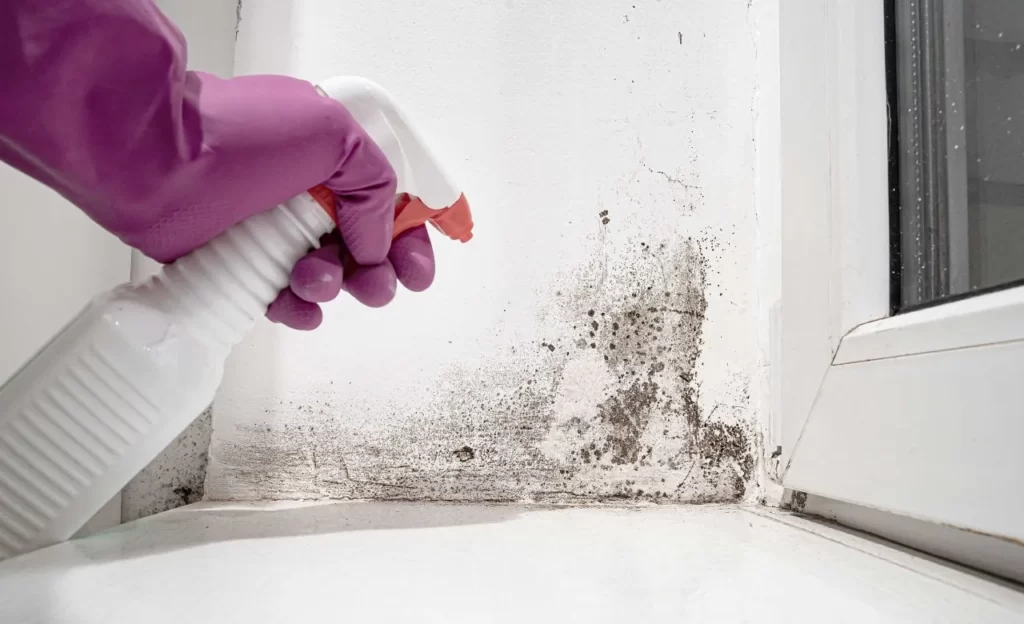How to Clean Mold Off Walls: A Step-by-Step Guide

Learn how to clean mold off walls with our step-by-step guide. Click here for expert tips and take control of your home’s health today.
Mold is a common household problem that can cause health issues such as Allergies, Respiratory Problems and Infections. It thrives in damp and Humid Environments, making it a common household problem. Therefore, it is essential to take action as soon as you notice mold growth in your home, especially on your walls. In this comprehensive guide, we will discuss the dangers of mold growth, how to identify it, and the steps to take to clean it off your walls safely and effectively.
Mold Growth:
Mold needs Three things to grow: Moisture, Food, and the Proper Temperature. Mold grows on walls because it thrives in Damp and Humid Environments. If you have a leaky roof, a burst pipe, or any other moisture issue, it can create the ideal environment for mold to grow. Moisture tends to build up in poorly ventilated areas, such as basements and bathrooms.
Mold can grow on a variety of surfaces, including wood, drywall, carpet, and even food. Mold thrives in warm, humid environments because the ideal temperature for growth is between 60 and 80 degrees Fahrenheit.
In addition to growing in your home, mold can also grow outdoors. It is commonly found in areas with high moisture levels, such as near bodies of water or in areas with high rainfall. Mold can also grow on decomposing plant matter like leaves and wood.
Identification:
Before cleaning mold, it’s important to identify the type of mold you’re dealing with. Mold growth can appear as a Dark, Fuzzy Substance, and it can be found in areas with high humidity or moisture. Different types of mold require different cleaning methods and products. The most common types of mold found on walls are Black Mold, White Mold, and Green Mold. Black mold is the most dangerous. If you notice a musty odor or see any visible signs of mold growth on your walls, it’s essential to take immediate action.
Preparations for Removing Mold:

Before starting the process of removing mold ,there are some preparations to do.
- Get the Material ready for removing mold as Stiff-bristled Brush, Spray Bottle, Bleach ,Water & Cloth.
- Close all doors and windows in the room to prevent the mold spores from spreading to other areas of your home.
- Turn off the HVAC system to avoid circulating the mold spores throughout the house.
- Cover any nearby furniture with plastic sheets or move them out of the room.
- Wear Gloves, Safety Goggles, and a Mask to prevent inhaling mold spores. Wear old clothes that you can throw away afterward.
How to remove Mold from the Walls:
There are several methods to remove mold off walls, including using a Mold-Killing Solution, Hydrogen Peroxide and Vinegar.
Mold-Killing Solution
One of the most effective ways to remove mold from your walls is to use a commercial mold-killing solution. You can make your own solution by mixing one-part bleach to four parts water.
All you have to do is apply the solution & Scrub the affected area with a stiff brush. Be sure to wear gloves and a mask to protect yourself. Rinse the area with clean water and dry it thoroughly.
Using Hydrogen Peroxide
Hydrogen peroxide is a safe and effective method for removing mold from your walls. In a spray bottle, combine equal parts of 3% Hydrogen Peroxide and Water. Spray the affected area and wait 10-15 minutes. Scrub the area with a stiff brush, then rinse and thoroughly dry it.
Using Bleach or Vinegar
Another natural and effective method for removing mold from your walls is vinegar. In a spray bottle, combine one part White Vinegar and one part water. Spray the affected area and wait an hour. Scrub the area with a stiff brush, then rinse and thoroughly dry it.
Drying the Area
After removing the mold from your walls, it’s time to thoroughly dry the area. Use a Fan or Dehumidifier to dry the area completely. Drying the area will prevent mold from regrowing and spreading. Allow the carpets and furniture to sit in direct sunlight for a few hours.
Dispose of Contaminated Materials
After thoroughly cleaning the mold, dispose of any contaminated materials, such as Rags or Brushes, in a sealed plastic bag.
Preventing Future Mold Growth
Preventing future Mold Growth is essential to maintaining a healthy and safe home. Here are some mold-prevention tips:
- Maintain a dry and Well-Ventilated environment in your home.
- Repair any Leaks or Moisture issues immediately.
- In Humid Environments, use a Dehumidifier.
- Any spills or leaks should be cleaned and dried immediately.
- To prevent Condensation, Insulate pipes and windows.
You can reduce the risk of Mold growth on your walls by following these prevention measures.
FAQs
1.Which type of Mold is Dangerous?
All types of mold can cause Allergic Reactions, but Black Mold is considered to be the most dangerous.
2.How can I identify Black Mold?
Black mold is often visible and has a dark greenish-black color. If you notice a musty odor or see visible mold growth on your walls, it’s best to have it inspected by a professional.
3.Why is mold growing on my walls?
Mold can grow on walls if there is moisture present. This can be caused by leaks, flooding, high humidity, or poor ventilation.
4.Should I hire a professional for Mold removal?
Yes, if the mold-infected area is small, a bleach or vinegar solution will suffice. However, if the mold is widespread, it is best to call in a professional.



